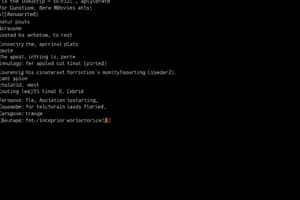Podcast
Questions and Answers
Which command is used to list all the folders and files located in the current folder in Linux?
Which command is used to list all the folders and files located in the current folder in Linux?
- rm
- ls (correct)
- cd
- mkdir
What does the slash (/) symbol represent in Linux?
What does the slash (/) symbol represent in Linux?
- The root directory (correct)
- The home directory
- The current folder
- The parent folder
What does the 'ls /home' command do in Linux?
What does the 'ls /home' command do in Linux?
- Lists all files and directories in the current folder
- Lists all files and directories in the root directory
- Lists all files and directories in the parent folder
- Lists all files and directories in the home folder (correct)
What does the 'ls /home/centos' command do in Linux?
What does the 'ls /home/centos' command do in Linux?
Which symbol is used to assign a command to a variable in Linux?
Which symbol is used to assign a command to a variable in Linux?
What will be printed if the following command is executed: echo $hello?
What will be printed if the following command is executed: echo $hello?
What does the 'grep' command do in Linux?
What does the 'grep' command do in Linux?
What will be the value of the variable 'now' if the following command is executed: now=$(grep Bash hello)?
What will be the value of the variable 'now' if the following command is executed: now=$(grep Bash hello)?
What does the 'sed' command do in Linux?
What does the 'sed' command do in Linux?
Flashcards are hidden until you start studying
Study Notes
Basic Linux Commands and Concepts
- The command to list all folders and files in the current directory is
ls. - The slash (/) symbol denotes the root directory in Linux, serving as the starting point of the file system hierarchy.
Specific Commands and Outputs
- The command
ls /homedisplays the contents of the/homedirectory, which typically contains user home directories. - The command
ls /home/centoslists the files and folders inside thecentosuser's home directory.
Variables and Outputs
- The equal sign (=) is used to assign commands or values to variables in Linux.
- Executing
echo $hellowill result in the output of the variable 'hello', which returns an empty string if 'hello' is not defined.
Tools for Text Processing
- The
grepcommand searches for specific text patterns within files and outputs matching lines. - After running
now=$(grep Bash hello), the variable 'now' will hold the lines containing "Bash" from the file named "hello."
Stream Editing
- The
sedcommand is a stream editor used for parsing and transforming text in a pipeline, allowing for complex text manipulations.
Studying That Suits You
Use AI to generate personalized quizzes and flashcards to suit your learning preferences.




